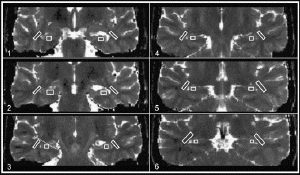Abstract
The objective of this study was to assess temporal lobe white matter (WM) quantitatively using T2 relaxometry in patients with pharmacologically intractable temporal lobe epilepsy (TLE). T2 relaxometry was performed using a dual-echo sequence with 23 contiguous oblique coronal slices in 56 consecutive TLE patients and in 30 healthy subjects. Averages of six slices were chosen to calculate T2 relaxation time in the temporal lobe WM (WM-T2) and the hippocampus (Hippo-T2). Twenty-seven patients had unilateral hippocampal atrophy (HA), and twenty-nine patients had normal hippocampal volumes (NV) on volumetric MRI. Mean WM-T2 was increased ipsilateral to the seizure focus in TLE patients with HA and those with NV (P < 0.001). Contralateral mean WM-T2 was increased in left and right TLE with HA (P < 0.001) and in right TLE with NV (P = 0.001). There was a positive correlation between WM-T2 and Hippo-T2. Individual analysis showed a prolongation of WM-T2 in about 70% of TLE patients with HA and NV. In half of the patients, WM-T2 increase was bilateral and symmetric. However, in 33% of patients with NV and bilateral symmetric increase in Hippo-T2, WM-T2 provided a correct lateralization of the seizure focus. Regardless of the pattern of T2 abnormalities, that is, bilateral symmetric or ipsilateral, the majority of patients with HA became seizure-free after surgery, while those with NV did not have a favorable outcome. In patients with NV, WM-T2 measurement may provide additional lateralizing information compared to Hippo-T2.

